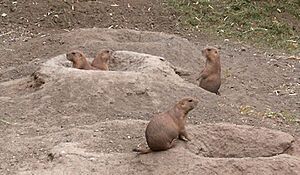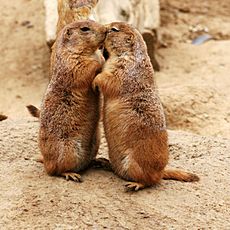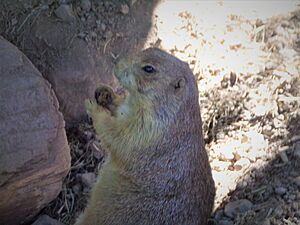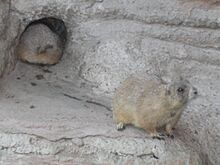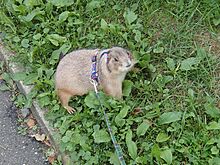Prairie dog facts for kids
Quick facts for kids Prairie dog |
|
|---|---|
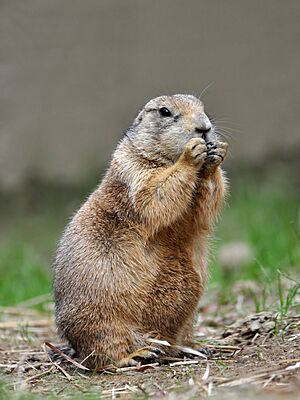 |
|
| Black-tailed prairie dog at the Smithsonian National Zoo Park in Washington, DC | |
| Scientific classification |
|
| Kingdom: | Animalia |
| Phylum: | Chordata |
| Class: | Mammalia |
| Order: | Rodentia |
| Family: | Sciuridae |
| Tribe: | Marmotini |
| Genus: | Cynomys Rafinesque, 1817 |
| Type species | |
| Cynomys socialis Rafinesque, 1817
(= Arctomys ludoviciana Ord, 1815) |
|
| Species | |
|
Cynomys gunnisoni |
|
Prairie dogs (genus Cynomys) are a type of ground squirrel that lives in burrows, or underground tunnels, in the grasslands of North America.
Contents
Distribution
You can find them in places like the United States, Mexico, and Canada. They mostly live west of the Mississippi River, but some have been moved to other areas.
Why are they called so?
Prairie dogs are named after the place they live, which is the prairie, and the sound they make. When they see danger, they make a barking sound to warn the others. People started calling them prairie dogs way back in 1774!
Even explorers like Lewis and Clark wrote about them in their journals in 1804, calling them "Prairie Dogs." Some Native American tribes also have their own names for prairie dogs. For example, the Lakota people call them "pispíza" or "pìspíza."
What do they look like?
Prairie dogs are chubby little animals with short tails. They are usually about 12 to 16 inches long and weigh between 1 and 3 pounds. The males and females can be different sizes, depending on the type of prairie dog.
Lifespan
Prairie dogs usually live for about 8 to 10 years in the wild.
Diet
Prairie dogs are mostly herbivores, which means they eat plants. They love to munch on grasses and small seeds. Sometimes, they might eat insects too.
In the fall, they eat broadleaf plants. In the winter, females will eat snow to get extra water. They also eat roots, fruits, and buds.
Different types of prairie dogs eat different things. For example, black-tailed prairie dogs in South Dakota eat bluegrass, blue grama, and buffalo grass. Gunnison's prairie dogs eat rabbit brush, tumbleweeds, and dandelions. Sometimes, white-tailed prairie dogs have been seen eating ground squirrels!
Where do they live?
Prairie dogs live in grasslands at high altitudes, usually between 2,000 and 10,000 feet above sea level. The weather where they live can be very hot in the summer and very cold in the winter.
Because they live in places with lots of storms, like hailstorms, blizzards, and floods, they need their burrows to protect them. The burrows also help them stay warm in the winter and cool in the summer.
Prairie dog tunnels help rainwater go into the ground, which stops erosion and helps the soil.
Prairie dog burrows are usually 16 to 33 feet long and 6.6 to 9.8 feet below the ground. The holes are about 4 to 12 inches wide. Some burrows have mounds of soil around them, which help them see predators and keep the water out.
Social organization
Prairie dogs are highly social animals. They live in large colonies or "towns", and collections of prairie dog families can span hundreds of acres. The prairie dog family groups are the most basic units of its society. Members of a family group inhabit the same territory. Members of a family group interact through oral contact or "kissing" and grooming one another. They do not perform these behaviors with prairie dogs from other family groups.
The typical prairie dog territory takes up 0.05–1.01 hectares (0.12–2.50 acres). Territories have well-established borders that coincide with physical barriers such as rocks and trees. The resident male of a territory defends it, and antagonistic behavior occurs between two males of different families to defend their territories. These interactions may happen 20 times per day and last five minutes. When two prairie dogs encounter each other at the edges of their territories, they stare, make bluff charges, flare their tails, chatter their teeth, and sniff each other's perianal scent glands. When fighting, prairie dogs bite, kick, and ram each other. If their competitor is around their size or smaller, the females participate in fighting. Otherwise, if a competitor is sighted, the females signal for the resident male.
Reproduction
Prairie dogs mate in their burrows, which keeps them safe from predators.
Females take care of the babies. They feed them milk, protect them, and collect grass for their nests. Males protect the territories and take care of the burrows.
Baby prairie dogs stay underground for the first six weeks of their lives. Then, they start to come out of the burrow. By the time they are five months old, they are fully grown.
Sometimes, prairie dogs will take care of babies that are not theirs.
How do they protect themselves?
Prairie dogs are very good at protecting themselves from predators. They have good eyesight and can see predators from far away. When they see a predator, they make a special barking sound to warn the others.
Scientists think that prairie dogs have a special language that they use to describe different predators. They can tell the others what the predator is, how big it is, and how fast it is coming.
When they hear an alarm call, prairie dogs will do different things depending on the predator. If the alarm is for a hawk, they will dive into their holes. If the alarm is for a human, they will all run inside the burrows. If the alarm is for a coyote, they will stand at the entrance of the burrow and watch it.
Scientists are not sure if prairie dog alarm calls are meant to protect themselves or to confuse predators.
One of the most interesting things that prairie dogs do is the "jump-yip." A prairie dog will stretch its body up and throw its forefeet into the air while making a call. When one prairie dog does this, the others nearby will do the same.
Threats
The prairie dog habitat has been affected by direct removal by farmers, and the more obvious encroachment of urban development, which has greatly reduced their populations. The removal of prairie dogs "causes undesirable spread of brush", the costs of which to livestock range and soil quality often outweighs the benefits of removal. Other threats include disease. The prairie dog is protected in many areas to maintain local populations and ensure natural ecosystems.
Why are they important?
Prairie dogs are considered a keystone species, with their mounds often being used by other species. Their mound-building encourages grass development and renewal of topsoil, with rich mineral and nutrient renewal in the soil, which can be crucial for soil quality and agriculture. They are extremely important in the food chain, being important to the diet of many animals such as the black-footed ferret, swift fox, golden eagle, red tailed hawk, American badger, and coyote. Other species, such as the golden-mantled ground squirrel, mountain plover, and the burrowing owl, also rely on prairie dog burrows for nesting areas. Grazing species, such as plains bison, pronghorn, and mule deer, have shown a proclivity for grazing on the same land used by prairie dogs.
In captivity
Sometimes, people keep prairie dogs as pets. However, they can be difficult to care for. They need a lot of attention and a special diet.
In the past, many prairie dogs were taken from the wild to be sold as pets. However, this is now illegal in many places because they can carry diseases.
In 2003, there was an outbreak of monkeypox in prairie dogs that were kept as pets. This led to a ban on the sale and transport of prairie dogs in the United States. The ban was lifted in 2008, but some states still have their own bans.
The European Union still has a ban on importing prairie dogs from the United States.
Prairie dogs in captivity can live up to 10 years.
Intersting facts about prairie dogs
- Their scientific name, Cynomys, comes from Greek words meaning "dog mouse."
- The explorers Lewis and Clark sent a prairie dog to President Thomas Jefferson during their expedition; it was quite strange to him.
- Prairie dogs have nursery chambers for their young, chambers for night, and chambers for the winter. They also contain air chambers that may function to protect the burrow from flooding and a listening post for predators.
- A prairie dog town may contain 15–26 family groups, with subgroups within a town, called "wards", which are separated by a physical barrier.
Images for kids
-
Skeleton of a black-footed ferret (Mustela nigripes) with a prairie dog skeleton, articulated to show the predator-prey relationship between them. (Museum of Osteology)
See also
 In Spanish: Perritos de las praderas para niños
In Spanish: Perritos de las praderas para niños


